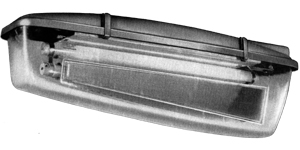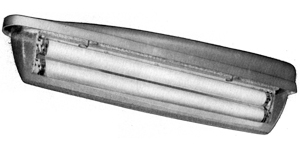 |
GEC Z8260
Genre: Enclosed Horizontal Traverse Tubular Fluorescent Lantern
After the invention of the tubular fluorescent lamp in 1937 by GE of America, its application to street
lighting was immediately recognised, but all development was delayed by the Second World War. After hostilities
ceased, trial installations using tubular fluorescent lamps were installed in Dublin (using trough
reflectors) and a year later in Rugby and London (using scientifically designed lanterns).
The advantages of fluorescent tubes was immediately apparent. The fluorescent tube was ideally suited for road
lighting, casting a wide beam across the road surface and was relatively unaffected by wet conditions
(which lead to streaks from more compact light sources). It's non-dazzling white light (due to the low
surface brightness of the tube itself) made it an ideal solution for the lighting of high streets, promenades and
civic areas, with smaller units used for residential streets. The only problem was the size of the tubes, which in turn
lead to large lanterns.
The first fluorescent lanterns were huge, bulky affairs, their size dictated by the bulb lengths, the enormous gear
and the limitations of the raw materials of the late 1940s: the lanterns consisted of plate glass panels and metal frames. The optical
system was also complex
treating each lamp as individual source and concentrating its beam in one area using parabolic polished
metal reflectors. Their large size, and equally large capital cost, made lighting authorities hesitant to use
these lanterns.
Fluorescent's popularity increased as new aluminium alloys allowed lighter one-piece canopies to be cast,
which in turn supported new plastic moulded bowls. The optical systems changed again with all the tubes
contributing to the whole: a primary system of lightweight plastic refractors directed the flux onto the road
surface and fashioned the main beams; whilst a secondary system (comprising of white over-reflector)
directed light above the horizontal back to the refractor plates.
Therefore the lanterns became simpler to manufacture and, in turn, their purchase price decreased. They
were still an expensive option, but authorities could justify their use due to their excellent white light (as
compared to the more "artificial" coloured mercury and sodium lanterns). Fluorescent lighting was especially
popular in new town developments and many manufacturers pointed this out in advertisements.
The lantern's large size was still a problem and manufacturers took a tip from European practise and angled
the lantern slightly to disguise its length. Whilst this threw the light further across the road, it was usually
done for cosmetic reasons alone.
The 1950s and 1960s were the age of the fluorescent lantern: it's white light seen as an energy efficient
replacement for ageing tungsten and gas lighting. As gear sizes were gradually decreased, the manufacturers
took advantage by streamlining the lanterns further. Optical systems became simpler until they eventually
consisted of no more than the tubes themselves with a small over reflector.
The energy crisis of the 1970s prompted a rethink. The complex white light fluorescent lantern, usually
burning multiple tubes, was seen as an expensive luxury: a unit burning two 40W bulbs could be replaced by
a single low pressure sodium lantern burning a 35W bulb. The idea that orange light was unsuitable for
residential areas and high streets was swept away by economic necessity. Therefore, as an energy saving measure,
the tubular fluorescent lantern was gradually removed, to the extent that hardly any exist on
public streets anymore.
The use of the tubular fluorescent lamp for street lighting was over. (Although the future looks bright for the
compact fluorescent lamp but that's another story...)

Name: GEC Z8260
Date: Circa Late 1960s - Late 1980s
Dimensions: Length: 29", Width: 6¾", Height: 7½"
Light Distibution: Non Cut-Off (BSCP 1004:1952)
Lamp: 2 x 40W MCFE/U

GEC Z8256

GEC Z8260
|
History
The GEC Z8260 was the final side-road fluorescent lantern designed by the GEC. It was a complete
redesign of the previous GEC Z8256 with a sleek new canopy and equally slim-line bowl. In fact, the whole lantern
was about compactness: from the operating gear tucked away over the gear tray to the two bulbs now mounted close to each other.
It was the last of its type due to fluorescent becoming extremely unpopular in the energy crisis of the 1970s. It was still
being sold in the late 1970s, but soon disappeared from the catalogues in the 1980s.
Popularity
The lantern was extremely popular and could be found in almost every town in the south-east. However, it wasn’t
installed by the roadside; it was British Rail's favoured lantern to light their platforms and many could be found
lighting the stations until quite recently. (This could be due to the GEC also providing early fluorescent lanterns
which bore station names).
It was also popular in some towns as a side-road street light. In particular, Cambridge used it as its side-road
lantern when REVO stopped manufacturing their Junior Sol-e-tern range.
Some very battered, and sorry looking, examples could still be found on Cambridge's streets in 2011,
although they will be swept away by the PFI.
|
Identification
The lantern has a very distictive profile and is easily recognised. However, like many other GEC lanterns, it
also has GEC Made In England cast into the canopy.
Optical System
The light output from this lantern is effectively uncontrolled. The designers were able to do this because of
the characteristics of the fluorescent tube e.g. these lamps already cast a wide beam towards the road surface
(so no spread in azimuth is required) and their low brightness doesn’t require any diffraction of the light to
reduce glare.
The only optical control is a white over reflector. This was originally the secondary optical system of the
GEC Z8256 and here it provides the same function, namely simply reflecting flux emitted above the horizontal
back down towards the ground.
The bowl has limited optical features and its primary function is to simply protect the tubes and keep the
interior of the lantern clean.
Gear
The lantern is fitted with a Thorn G69082.4 quickstart gear and GEC power correction
capacitor. Clearly the gear is not the original.
The bi-pin fluorescent connectors are not earthed, suggesting these lanterns used MCFE/U lamps.
The GEC Z8260 In My Collection
|

|
|
facing profile
This lantern was obtained from fellow collector Bob Cookson. Nothing is known of its service
history except that it originally came from British Rail so lit a platform somewhere.
|
|

|
|
front profile
The lantern was initially in a very grubby and dirty condition with much flaking of the interior paint and
smears of other paint over the canopy – probably from a repaint of its column. However, it was complete and
simply required a strip-down, repaint and clean.
|
|

|
|
trailing profile
This view shows the classic lines of this lantern and also how compact it was.
|
|

|
|
canopy
Two pairs of springed stainless steel catches held the bowl in place. This was also a method used by the GEC
on other lanterns of the same era.
|
|

|
|
logo
Like many GEC lanterns, the lantern has the makers name cast into the canopy of the lantern. They often included an
identification sticker inside the lantern as well, but if one was ever fitted, it has long since disappeared.
|
|

|
|
pedestrian view
The bowl was just big enough to accommodate the two closely-spaced fluorescent tubes. It was about half
the depth of its predecessor, the GEC Z8256.
|
|

|
|
vertical
The vertical view shows how the bowl provided little optical control. There were not refractor plates,
no diffuser patterns or any other embellishment. The bowl was simply to protect the tubes from the elements
and prevent them from getting dirty.
|
|

|
|
open bowl
Once opened, the bowl provided access to the cramped tubes (held in place by stainless steel clips and bi-pin connectors)
and the gear tray. The latter was also attached to a small section of chain, so the whole assembly could be taken out,
and allowed to hang free.
|
GEC Z8260: During Restoration
Despite its years of service, the lantern was in remarkably good condition. It was stripped down and given a good
clean and the rusty over reflector was stripped and repainted.
The following pictures were taken as the lantern was reassembled.
|

|
|
canopy exterior
The canopy was given a liberal dose of paint remover and scrubbed until shiny. The
bowl would've been difficult to remove for what was just a cleaning exercise so was left in-situ.
|
|

|
|
canopy interior
The interior of the canopy was extremely basic. It only provided mounting points for the gear tray,
earthing screw and grub screws.
|
|

|
|
gear tray
All the other electrical connections, the terminal block, quick-start unit and power correction capacitor
were mounted on the top-side of the gear tray. They're seen here after being remounted on the repainted gear tray.
|
|

|
|
final assembly
And after connecting the external wiring and fitting the repainted over reflector, the restoration of this lantern was now complete.
|
GEC Z8260: At Night

GEC Z8260: As Aquired
Originally an extremely popular lantern, this GEC is now rather rare, not many surviving the great purge of
fluorescent lanterns around the country.
It was the standard fluorescent side-road lantern for the Cambridge, where it was used in the 1970s and 1980s when the
REVO Junior Sol-Etern range was discontinued. Some examples managed to escape the SOX replacement scheme of
the 1980s and 1990s, and were still in service until 2011.
It was also British Rail's lantern of choice for lighting station platforms, where this example came from. Some can still be found in the
south of England, but they're gradually disappearing now.

|



